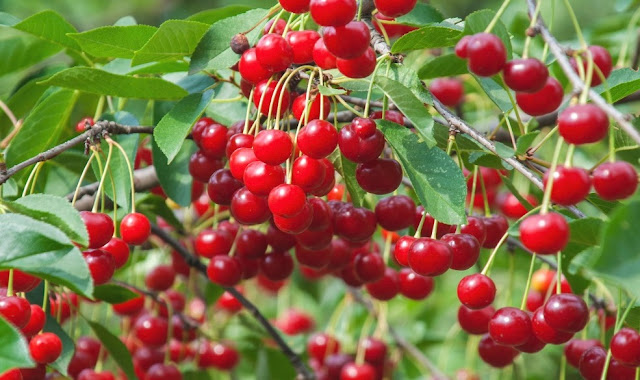Benefits of eating cherries
Cherries: Healthy fruit for sweet and savory dishes
Cherries are very healthy and not only do they taste
delicious, but they can also be easily made into cakes, desserts or sauces.
Tips on removing seeds, preserving, thickening and recipes.
Summer is a fun time. The aromatic fruit is sold fresh from around June to the end of August. Cherries are available in hundreds of varieties. A basic distinction is made between sweet and sour cherries. There are two types of sweet cherries – hard-fleshed cartilaginous cherries, also known as button cherries, and soft-fleshed heart cherries. Both taste best fresh, straight from the tree.
The first pink varieties hit the market in late May, followed by the dark red varieties in July. Sour cherries, on the other hand, taste, as the name suggests, slightly sour and are ideal for baking, jam or compote. The most famous sour cherry variety is the dark red morello cherry.
Buy cherries from the garden or pick them yourself
In Germany, cherries grow in many regions, but customers
often search in vain for these regional fruits in supermarkets. Cherries from
abroad are often offered there; only a third of local fruit is sold in retail
stores. If you want to buy cherries from the area, it's best to go to the
weekly market or buy them directly from the orchard. Advantages: The cherries
there are fresher than in the store. Many farms in the north also offer
visitors the opportunity to pick their own cherries – it's fun and saves money.
In northern Germany, the Altes Land on the lower reaches of the Elbe is the
largest cherry producing area. Cherry blossoms begin to bloom there in late
April and turn thousands of trees brilliant white.
Wash cherries just before eating
Once harvested, the fruit will be stored in the refrigerator for several days. Important: do not throw away the stems and only wash them just before consuming. Without stems, cherries have sores that attract fruit flies and quickly cause the fruit to become mushy. Temperature fluctuations also damage the fruit. They start to sweat a little and then become moldy.
Processing cherries - that's how it works
Before being processed in the kitchen, the fruit must be deseeded - a rather laborious task. This can be done with a very sharp knife or a special corer. As a simple aid, place the cherry with its stem on the neck of the bottle and press the hole from above with a blunt stick, such as a shish kebab skewer or Asian chopsticks. Tip: Put the cherries in the freezer for a while first so the pits come out more easily.
Freezing: can be done with or without seeds
Cherries are good for freezing - both with and without pits. The easiest way is to spread the fruit side by side, perhaps on a plate or tray, and put it in the freezer for about an hour. Then fill them into freezer bags.
Blanch the cherries and thicken the juice
Alternatively, you can preserve the cherries by boiling them. To do this, boil one liter of water with around 300 grams of granulated sugar for every kilogram of cherries until it dissolves. Pour the washed cherries into a clean glass, leaving a little space around the rim. Pour in the sugar water which is no longer boiling so that the fruit is completely covered.
Cover the jars and place them in a large saucepan. They should not come into direct contact with the floor, so it is best to place a folded or gridded tea towel inside. Fill the pot three-quarters full with water, cover and cook the cherries at about 80 degrees for 30 minutes. Pay close attention to the temperature, preferably with a thermometer, and don't leave the pot unattended. Cherries last for months when cooked or made into jam.
Cherries with sauce are often served with desserts such as
ice cream, pudding, or waffles. It can consist of boiled stock or cherry juice.
So that it's not too runny, it's best to thicken it. It works best with
cornstarch. Mix this with a little cold water or juice, add to the boiling
stock, stir and let steep a little.
Recipe with cherries
Whether as red fruit jelly or in cakes: cherries often play
a starring role, especially in desserts and sweet pastries. Fruit is also a
great ingredient for raw salads or dips. Recipe options:
Cherries are healthy: lots of vitamins, few calories
Cherries are not only delicious and aromatic, even though they are sweet, they are also low in calories and healthy. They consist of 85 percent water and only have 55 kilocalories per 100 grams because they contain only a small amount of carbohydrates. The fruit also contains:
Vitamins A, B and C
Folic acid - important for cell division and blood formation
Magnesium for muscles
Potassium - regulates salt balance
Calcium, manganese and iron for bones and teeth
fiber
Anthocyanins are natural plant pigments that have
anti-inflammatory effects and protect cells from premature aging.
Half a liter of cherry juice fulfills a person's daily vitamin C requirements. Cherries are also said to help overcome rheumatism, gout and bladder stones.
Can you drink water with cherries?
The famous rule is: Don't drink water with cherries! That's
no longer true. The recommendation comes from the past when water was often
contaminated with yeast. They let the cherries ferment in the stomach and cause
flatulence. However, cherries have a slight laxative and diuretic effect.



